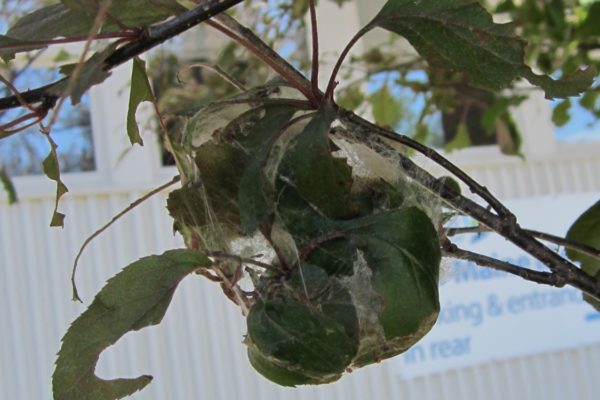A common concern and nuisance this time of year is the browntail moth. Their nests look like webs, and appear primarily in oak and apple trees. Larval feeding can cause reduced growth and death in trees and shrubs.

Do you have browntail moths on your home or business? Contact Modern Pest today for a free quote!
Why They’re a Threat to Humans
The biggest concern to humans is contact with the moth’s poisonous hairs. The largest amount of hair activity occurs from June through August. The moth sheds its toxic hairs, which become airborne or attach to leaves and brush. When they contact skin, the barbed hairs produce an itchy, painful, poison ivy-like rash that can be severe for some people.
Inhaled hairs can also produce respiratory problems, especially in people with asthma. The hairs can cause a burning, itching sensation in the mouth and throat.
How to Get Rid of Them
The best time to remove the nests is in winter or early spring when the larvae are dormant. By late June, the larvae have spun cocoons in which to pupate. These pupal cocoons are full of toxic hairs and should only be removed from trees and buildings with great caution.
“This isn’t the most effective time to really treat for these moths,” Mike Peaslee, Modern Pest’s Technical Director said. “It’s best to treat in spring, about through the end of May, when the larvae, or caterpillars, are exposed to the treatment before they form cocoons to pupate into the adult moth.”
When treating trees, shrubs, or any other type of foliage, an arborist is needed. Certain arborists possess the required licensing and equipment to treat these specific areas when they become infested with browntail moths. These areas are often high in the trees.
The Maine Department of Agriculture, Conservation, and Forestry has put together a list of licensed pesticide applicators willing to treat browntail moths. Follow the link below to see the list:
The Modern Solution
Modern Pest Services can treat for the adult browntail moths when they are on structures. We cannot treat trees, shrubs, or any type of foliage for these moths, only structures. Treatment for trees, shrubs, etc. will still require an arborist.
“These moths typically hatch in late June and early July, and through about the beginning of August,” said Mike Peaslee, Modern Pest Technical Director. “This year, particularly in coastal Maine, they have been a very serious problem. In some cases, there have been hundreds of moths all over people’s homes and businesses.”
Modern Pest Services is now offering a one-time service for both Residential and Commercial clients. The service is focused on providing temporary relief during the period when the moths are hatching into the adult stage. At this point, they are attracted to the lights from buildings. Within a few days of Modern Pest’s treatment, the moths will be killed.
“While most of the adult moths will hatch within a few days of each other, there may be some in the caterpillar stage that will continue to pupate and hatch during about a 30-day period throughout the month of July to early August,” Mike Peaslee said. “The residual material will continue to work to help eliminate any additional adult moths that hatch and are attracted to the structure.”
The focus of the treatment is particularly on wooded sides of structures where the moths develop in deciduous trees and shrubs, as well as around areas of the structure with exterior lighting to which the moths are attracted.
For more information about the service, and a price quote for the one-time treatment, please call Modern Pest at 1-800-323-7378.
For more information on the browntail moth, and for ways to control their presence, check out this link from the Maine Forest Service:
